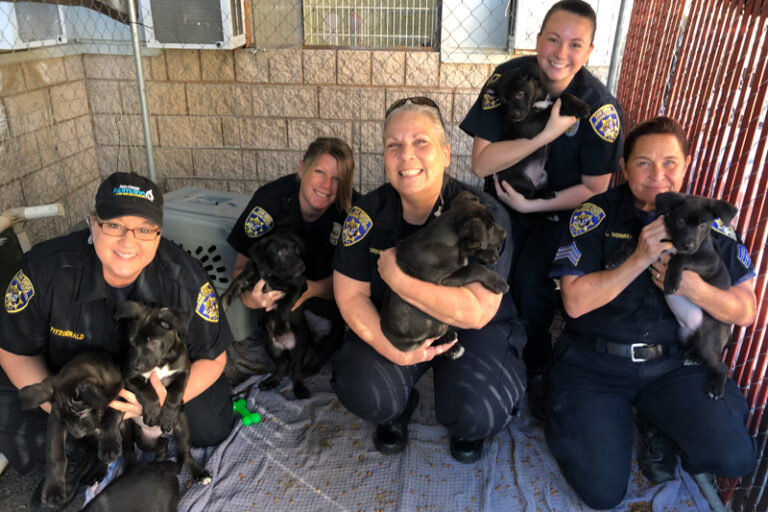Picture this. There is a large white vehicle in your driveway and someone in uniform knocks on your door. How would you react? Seeing that they are an animal control officer trying to find out if the lost pet they found is part of your family, you might open the door. You might recognize your cat and be reunited right there on your doorstep.
Or, you might see the van and the uniform and become frightened. You aren’t sure what the officer is there for and are reluctant to open the door. You are having difficulty understanding what the officer is saying and find it safer to stay inside and wait. In this instance, there are barriers in the way of being reunited with your animal.
This is a real struggle that some families have to navigate, but that not everyone may be familiar with.
Only 17-19% of lost pets brought into the shelter are reunited with their families, but it’s not because people don’t want to find their loved ones. The inability to afford to pay reclaim fees, not having access to the internet, long working hours and fear, are just a few of the many barriers to getting a lost pet back that, depending on your life and experiences, you may not think about.
“There’s this privileged point of view that people don’t deserve their animals if they don’t put in what we consider our standards to be of levels of effort, and that’s exclusive. We can’t blanket our communities with our own points of view and our own prejudices.”
– Michelle Dosson, Bureau Manager, Norfolk Animal Care & Adoption Center.
Before we are quick to judge people who have lost pets, we must understand where different communities are coming from.
Reclaim fees are an immediate barrier that some shelters are trying to overcome. When a family loses their animal, someone finds them and that animal is brought into the shelter, the guardian may be charged a fee before they can bring their furry family member home, that is if they even find out the pet is at the shelter. Sometimes these fees grow by the day, sometimes they are increased after each time the pet enters the shelter. The purpose of reclaim fees is not meant to be a barrier in and of itself, but families who have trouble affording the cost of their pet’s intake, microchip, or vaccines at that moment see it as a wall preventing them from reuniting with their animal.
Many pet guardians have to prove the animal is theirs as well. They need a valid ID, like a driver’s license, and proof of ownership, like a rabies certificate that connects them to their animals. However, it cannot be assumed that every pet owner has these things or in ways that are accepted. El Paso, Texas, has a population of 685,575. Two-thirds of the population speak Spanish and about 12% are not U.S. citizens. El Paso Animal Services cares for 27,000 animals a year in this city along the U.S.-Mexico border. When Paula Powell, director of El Paso Animal Services, started experiencing barriers regarding identification and language, she worked to remove them. “You don’t have to show documentation to reclaim a pet, just some form of ID. It can be an ID from another country,” she says. There continues to be a push for more Spanish language availability at the shelter and in community outreach programs to further support El Paso’s Latino communities.
Dosson remembers her stumbling attempts at speaking Spanish when she worked with Austin Animal Services in Texas. She wasn’t fluent in Spanish and at times visitors weren’t fluent in English, but there was mutual respect that both parties were putting in the effort to connect. Austin has a rich Deaf community, and after Dosson learned sign language, the same held true. “It’s incredible how much connectivity you get when you make the effort to learn people’s language,” she says.
These barriers may pop up when a person visits the shelter to look for their lost pet, but for some, it’s hard to even make it there. If a shelter is only open a few hours a day, it might be extremely difficult for a commuter to find the time for a long drive during work hours. If a family is able to visit the shelter for the day but has young children at home, they might not be able to arrange for child care and may opt to stay home instead. Older adults and others might not drive, or some people may not have consistent access to a car. These are all barriers that prevent people from visiting the shelter to look for their animals.
Some people run into challenges like these during the reclaim process and others just don’t know where to start. Many times, shelters and community members will post photos on Facebook or Nextdoor of lost pets, which are shared by a community that truly does want to bring families back together. And many times, this works out.
The problem is that not everyone who loses their animal has access to Facebook and Nextdoor to check if they’ve been found. “In the pandemic, a big barrier is only being able to look on the website when they used to come in to look for a pet,” says Michele Anderson, public affairs coordinator of El Paso Animal Services. Communities are seeing the value of communicating in different ways, such as word of mouth, which remains the most effective way to let people know what services are available and where to find them.
Social media has been useful in recent years to reunite families, but it is also not something to take for granted. If a pet is driven out of their community to a local shelter, sometimes maybe 10 or 20 miles away from where they were lost, how can we make sure people know where to turn to? And when they get there, how can we make sure they feel welcome and supported?
Today at Norfolk Animal Care & Adoption Center, more than half of lost animals are reconnected with their people. Building a relationship of trust and open dialogue is one of the keys to reuniting pet families, and that work starts within communities. First, getting to know the individuals around you makes supporting each other much more natural when the time comes. Next, community leaders should be a bridge between the members of their community and shelters, so that each component is aware of the other’s needs. Lastly, it can be difficult to understand something if you haven’t gone through it. In the various crises we face now, it seems some of us are relearning the strength of our communities. You might do something one way and your neighbor another, but a safe and loving family can look different for different people and different pets.








